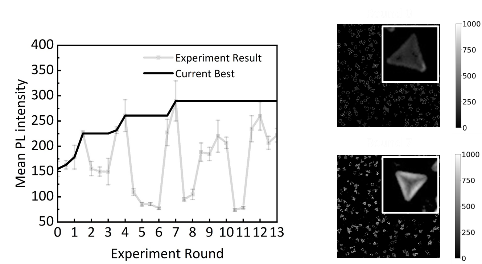Quantum Materials Field
2D Quantum Materials Group
Our research team intends to investigate the intriguing characteristics of low-dimensional nanostructures, with a particular focus on two-dimensional (2D) crystals.
Group Leader: Ryo Kitaura
Developing BO-guided MOCVD growth method and polarization-resolved microspectroscopy of moiré superlattices
Current Topics
We are focused on enhancing the capabilities of 2D systems by integrating advanced preparation methods, spectroscopy, and theoretical analysis. The development of experimental and theoretical tools is crucial for this research. For instance, we are in the process of developing fully automated metal-organic chemical vapor deposition systems for 2D materials. This system will incorporate machine learning techniques to achieve high-quality, customized 2D materials and heterostructures in need. Also, we are developing novel quantum light sources using 2D semiconductors and heterostructures. By combining advanced microfabrication and micromanipulation techniques, we aim to incorporate 2D heterostructures into nanodevices, allowing for efficient control in designing tailored quantum light sources.
Outline of Research
We employed Bayesian optimization (BO) to enhance the growth of monolayer WS2 by utilizing photoluminescence (PL) intensity as the objective function. The application of BO-guided experiments resulted in an 87 % improvement in PL intensity over the course of 13 experimental rounds. Through statistical analysis, we identified critical growth parameters, specifically tungsten source concentration and argon flow rate. In comparison to random search methods, BO demonstrated a more rapid convergence, thus highlighting its potential to expedite the synthesis and optimization processes of two-dimensional materials. Additionally, we are conducting research on polarization-resolved microspectroscopy of two-dimensional moiré superlattices to facilitate the control and detection of the quantum states of moiré excitons. Our recent investigations have revealed an intriguing relationship between moiré superlattices and the light polarization of photoluminescence, thereby establishing a foundation for the future control of quantum states.

Fig. 1. Evolution of PL intensities in a BO process. Mean PL intensities of WS2 increases during the BO process.
References
- F. Zhang, R. Tamura, F. Zeng, D. Kozawa, R. Kitaura. ACS Appl. Mater. Int. 16 , 59109 (2024). DOI: 10.1021/acsami.4c06116
- F. Zhang, F. Zeng, D. Kozawa, R. Kitaura. Crystal Growth & Design. 24 , 6001 (2024). DOI: 10.1021/acs.cgd.4c00382
- Y. Jiang, T. Kariyado, X. Hu. J. Phys. Soc. Jap. 93 , 033703 (2024). DOI: 10.7566/JPSJ.93.033703
Group members
-
 Ryo Kitaura・Group Leader
Ryo Kitaura・Group Leader -
 Daichi Kozawa・Principal Researcher
Daichi Kozawa・Principal Researcher -
 Toshikaze Kariyado・Researcher
Toshikaze Kariyado・Researcher
Activities
-
Feb 27, 2024
Links


